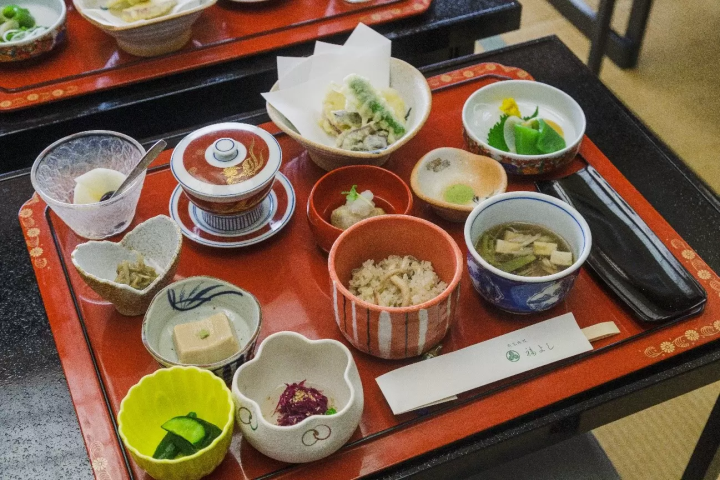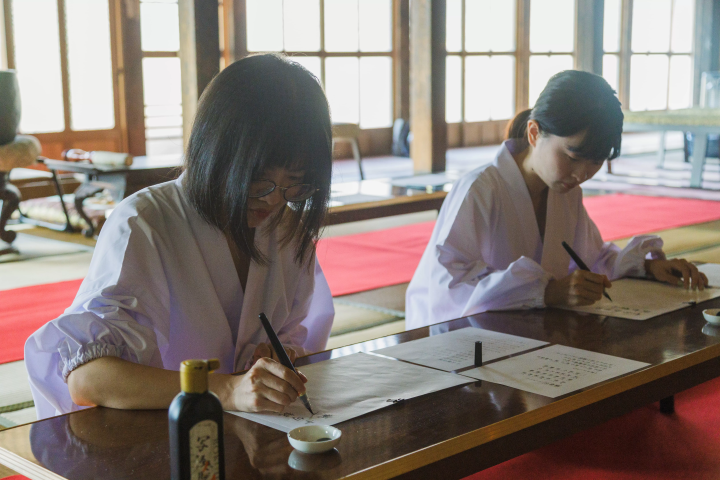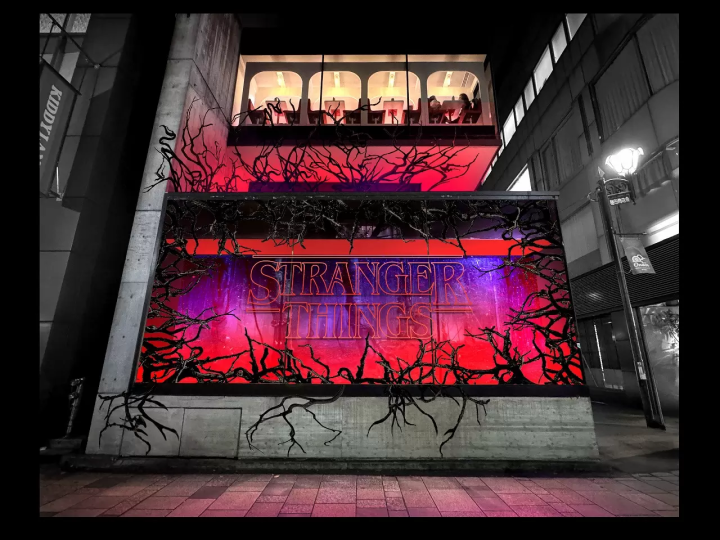Spiritual Culture at Jionji Temple: Training and shojin ryori at the leading prayer temple in the Tohoku area

A special two-day, one-night tour at Tohoku's leading prayer temple, Jionji Temple, located in Sagae City, Yamagata Prefecture. Attain invisible spiritual richness and a healthy body through the activities featured in this tour. Travel with a Yamabushi mountain ascetic along a former Shugendo trail while dressed in all-white training clothes, try shojin ryori traditional vegetarian cuisine, learn one of the Bugaku (a traditional performing art) dances at Jionji, and experience the spiritual cult...
What kind of place is Sagae? How do you get there from Tokyo?

Sagae City, Yamagata Prefecture, where Jionji Temple is located, is a city located almost in the center of Yamagata Prefecture. It is surrounded by mountains such as Mt. Gassan, the famous Dewa Sanzan, the Asahi Mountain Range, and the Ou Mountain Range, and is an area rich in nature with the Mogami River and the clear Sagae River flowing through the city. Fruits such as cherries and La France are local specialties, and one of the attractions is that you can encounter a variety of flavors throughout the year.
Access from Tokyo Station to Sagae Station takes about 3 hours via Yamagata Shinkansen Yamagata Station. The meeting point for the tour we are introducing this time is Yamagata Station, so it can be accessed from Tokyo Station in about 2 hours and 30 minutes. Also, it takes about an hour to get from Sendai Station to Yamagata Station using the JR Senzan Line, so it is an easy place to travel around within the Tohoku region.
Limited to one group per day! What are the highlights of the "Spiritual Culture of Prayer Tour"?

This two-day, one-night tour is limited to one group per day, so you can enjoy a trip full of privacy with your friends, family, or partner. Another highlight is that it is a special program that is not usually offered and was created just for this tour, so you can have a rare experience that you can't get anywhere else. The program offers attractive content such as trekking on the Shugendo trail with a mountain ascetic, traditional vegetarian cuisine, a Bugaku experience, and a sutra copying experience. A spiritual experience that will enrich your body and mind awaits you at the historic Jionji Temple, which stands in the midst of majestic nature.

The tour fee includes accommodation at a traditional Japanese inn, various programs such as sutra copying, Bugaku, and Shugendo trekking, and meals (lunch, dinner, and breakfast), and starts from 88,000 yen (tax included) per person. Applications can be made through a travel agency that can handle multiple languages, and an interpreter will accompany you on the day, so even those who are worried about Japanese can stay. In addition, from the time of meeting to the time of disbanding, you will travel in a special minibus, so you can stay without any worries.
[Check out the tour details here!]
Here's a full rundown of this two-day, one-night tour that will give you a special experience!

Now, let's take a closer look at the two-day, one-night tour. If you're interested in the tour, be sure to check out the URL at the end of the article.
[Day 1] Become healthy from the inside out! Taste vegetarian cuisine and experience training at the Amida Hall
Enjoy a vegetarian lunch at "Kappo Ryokan Fukuyoshi"

The first place we visit on the first day is "Kappo Ryokan Fukuyoshi." It is a small inn with only five rooms, and has a quiet and calm atmosphere. After arriving, we check in and immediately change into our training clothes.

The training clothes are white clothing called shirosozoku. The white color represents purification and purity, and is the clothing worn when a baby is born or when a deceased person departs. When you put your arms through the sleeves, you feel a sense of determination for the training that is about to begin, and your back will mysteriously straighten up.
Once we got changed, it was just time for lunch. The shojin ryori we were going to try today is a plant-based diet based on Buddhist teachings that does not include meat or fish, and developed as a meal for monks. Here at Fukuyoshi, we can enjoy nutritious dishes made with local Sagae ingredients, based on the shojin ryori recipes handed down at Jionji Temple since ancient times.

Experience Jyogyo-Zanmai and Bugaku at the historic Jionji Temple

After filling our stomachs with vegetarian cuisine, we head to Jionji Temple. With a history of about 1,300 years, this temple flourished as the largest temple in the Tohoku region during the Edo period and is also designated as a national historic site.

At Jionji Temple, you will start with a tour of the temple grounds. The grounds include the main hall, mountain gate, Yakushido Hall, and three-story pagoda, and are home to cultural assets such as Buddhist statues, paintings, and Buddhist implements from the end of the Heian period to the Kamakura period. With the head priest as your guide, you will learn about the history and charm of Jionji Temple, further deepening your understanding of Buddhism and spiritual culture.

Next, you'll visit the Amida Hall, which is not normally open to the public, and experience a training called "Jogyo-Zanmai." A seated statue of Amida Nyorai is enshrined in the center of the square-shaped Amida Hall, and there is a large space around it that you can walk around. "Jogyo-Zanmai" is a training in which you continue to walk around Amida Nyorai while chanting "Namu Amida Butsu." It is originally a harsh training that is done day and night for 90 days, during which you are not allowed to sit down even if you are tired. On this tour, you will casually experience "Jogyo-Zanmai" by going around the hall seven times, and get a sense of your mind being sharpened.

The next experience is "Jionji Bugaku," which is designated as an Important Intangible Folk Cultural Property of Japan. "Issaikyoe," held every year on May 5th, is the most important ceremony at Jionji Temple, where all sutras (Buddhist teachings) are offered, and "Jionji Bugaku," which has a tradition of 1,200 years, is dedicated to pray for a good harvest.

Of the eight dances, on this tour you will be taught the Taiheiraku dance, which features heroic armored figures. Learn the dance under the teacher's guidance, and at the end take a commemorative photo with the armor and sword. By experiencing this precious Bugaku dance for yourself, which can only be seen once a year, you will surely create another special memory.

End the first day with a little tipsy fun by going bar hopping

After completing your Buddhist experience, you will move to your lodging, take off your training clothes and return to the secular world. In the evening, you can go bar hopping while feeling tipsy. You will visit an izakaya where you can enjoy seasonal Yamagata ingredients and local sake, and a snack bar where you will be treated by a friendly hostess, and fully enjoy the nightlife of Sagae. Of course, the cost of meals is included in the tour price, so you can enjoy to your heart's content♪


There was so much to cover that the day just flew by. We had so much to talk about because it was our first time, but we all decided to go to bed early to prepare for the next day and the first day came to an end.
[Day 2] Let's set off on a trekking expedition along the Shugendo trail with a mountain ascetic!
A vegetarian breakfast and a sutra copying experience to get your mind in order

On the morning of the second day, we changed into our training clothes and had a vegetarian breakfast before setting off. We headed to Jionji Temple again, and first had a "copying sutras" experience at Kegon-in Temple, located within the old temple grounds. "Copying sutras" is the act of copying sutras, and it began as a part of Buddhist training and a way to spread Buddhist teachings.
During the sutra copying experience, the head priest will recite the sutra, and you can take your time to face your own heart in a solemn, beautiful, and mystical space. A draft is provided for copying the sutra, so all you have to do is trace the kanji. Even people from countries where they are not accustomed to kanji can feel at ease. Calm your mind and carefully write each character while putting your wish into it.


Set off on a Shugendo trek with a mountain ascetic

After the sutra copying experience, we will move on to the Shugendo trail trekking, which is the highlight of this tour. After receiving an explanation and a prayer, we will move to the trailhead by minibus.
"Shugendo" is a uniquely Japanese religion that was formed by mixing elements of Shinto, Buddhism, esoteric Buddhism, and mountain worship. Those who have acquired magical abilities and the mysterious power of the mountains known as "genriki" through training in the harsh mountains are called shugensha or yamabushi.
Until Shugendo was abolished in 1872, Jionji Temple carried out its own Shugendo training, and it is said that people would stay in seclusion at the first, second, and third lodgings within the mountain for up to 30 days at a time.

On this tour, you will wear original Shugendo attire and visit the training grounds, simulating the training of those days. The mountain ascetics of Jionji Temple will lead the way, and you will purify your mind by chanting "kake nembutsu" prayers for the fulfillment of wishes and bountiful harvests as you climb. Along the way, you will come across the remains of a hall that was dedicated to En no Gyoja, the founder of Shugendo, and to Baramon Sojo, who is said to have founded Jionji Temple, and you can continue walking at your own pace while paying your respects.

Passing through the Kentenjo and Shijuhachimori forests, where the ascetic monks are said to have run, and climbing up a steep slope, you will reach the summit of Aizengatake, where a sacred cedar tree stands. The sight of the sacred tree at the summit and the solemn atmosphere will make you feel the same way as the ascetics of the time.

Finally, you will report your safe return at the Fudodo temple. The two-day, one-night trip ends with the Shugendo trail trek. You will feel pleasantly tired, and your mind and body will be purified over the two days, giving you a sense of spiritual growth.
Enjoy a highly satisfying 2-day, 1-night tour that will allow you to experience Japan's spiritual culture!
Applications are being accepted on the tour's dedicated website, where you can gain spiritual richness and physical and mental health through various training experiences centered around Jionji Temple. Participants who have participated so far have given positive feedback, such as "I would recommend this to tourists who want to visit a remote place outside of the city!" and "I was able to understand the Japanese view of nature and religious tolerance." Why not visit Sagae and create special memories that you can't find anywhere else?
▼For more details and to apply, click here▼
This is a special two-day, one-night program at Jionji Temple, Tohoku's leading prayer temple in Sagae, Yamagata Prefecture, to help you attain invisible spiritual richness and a healthy body. Dressed in training clothes, you will travel with a mountain ascetic along the old Shugendo trail, experience traditional vegetarian cuisine and dance, and experience the spiritual culture that is deeply rooted in Tohoku. In this article, we will introduce the whole picture of the tour.
The contents on this page may partially contain automatic translation.



![[Souvenirs] 7 Yamagata Souvenirs](https://resources.matcha-jp.com/resize/720x2000/2023/07/12-141002.webp)



























![[2026 Edition] FORMUAL 1 JAPANESE GRAND PRIX Information](https://resources.matcha-jp.com/resize/720x2000/2025/10/05-245984.webp)


![[2025 Update] Namba's spectacular illuminations! "Namba Hikari Tabi" with approximately 1 million shining lights](https://resources.matcha-jp.com/resize/720x2000/2025/12/12-252825.webp)